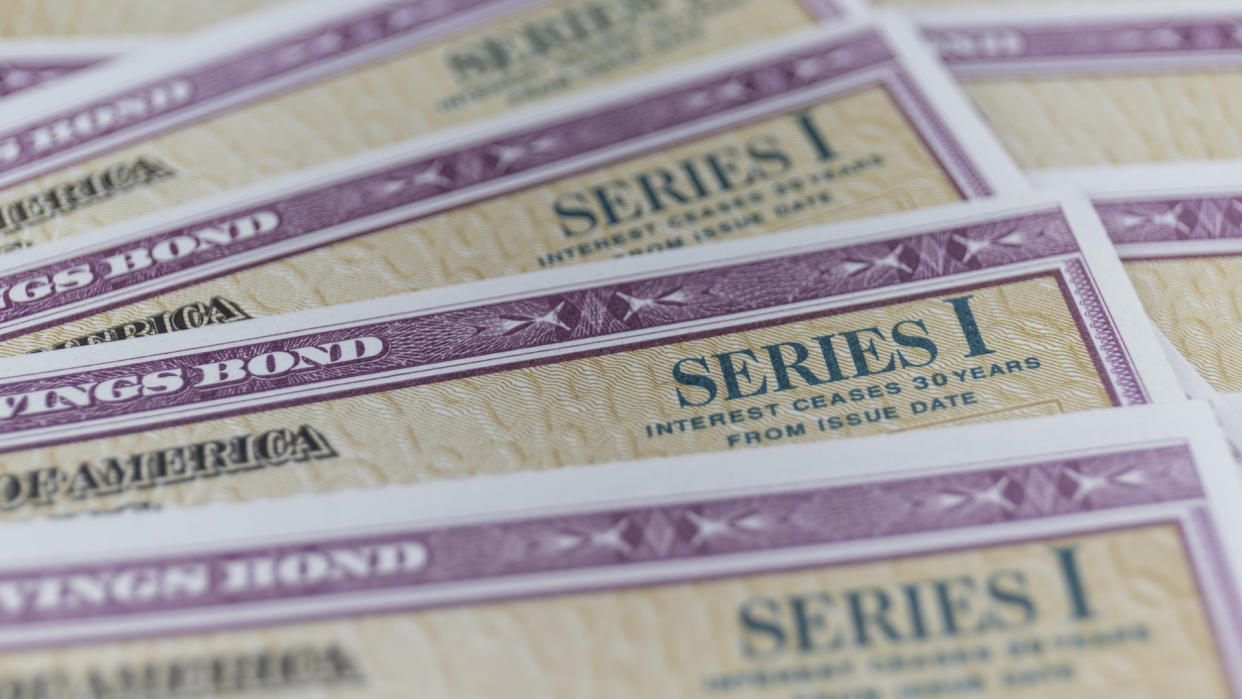Inflation Spotlight: Everything You Need To Know About Series I Bonds

If you’re looking for a low-risk asset where your money may grow faster than the current inflation rate, Series I bonds could be the answer, experts say. But what are Series I bonds and how can you invest?
What Are Series I Bonds?
You may have heard that when interest rates rise, bond prices fall as bond yields grow. Series I bonds are the investments being referenced in this scenario. And with interest rates skyrocketing, investors are scrambling to scoop up Series I bonds.
See: 5 Best Southern Cities To Retire on a Budget of $1,500 a Month
Find: Here’s How Much Cash You Need Stashed If a National Emergency Happens
Series I bonds have a fixed rate and a variable rate. The variable rate adjusts every six months based on the Consumer Price Index, which is one of the main measures of inflation in the U.S.
Series I bonds purchased through Oct. 2022 will yield a 9.62% return for the first six months after purchase. After that, the rate will be adjusted for inflation. Interest on Series I bonds is compounded semi-annually.
The downside? The process to buy bonds is not as easy as you might imagine. It requires more than just downloading an app and making your choices, as you would to invest in stocks. CNBC recently quoted financial planner Matt Stephens, who likened the process of buying bonds to “going to the DMV online.”
What You Should Know Before Investing in Series I Bonds
You can purchase I Bonds, as they are called, through the government website TreasuryDirect.gov. You can buy electronic bonds in any amount from $25 on.
You can only purchase paper bonds using your federal income tax refund money, and they are available in $50, $100, $200, $500 and $1,000 increments.
Each calendar year, you can purchase up to $10,000 in electronic I bonds and up to $5,000 in paper I bonds. You buy bonds at face value, so you’ll pay $50 for a $50 bond.
If you’re considering investing in bonds, keep in mind that you’ll need to hold the bond for at least one year. And if you cash it in before five years, you will lose the previous three months of interest. When you sell a bond, you’ll need to pay federal income tax on the interest.
Related: 6 Alternative Investments to Consider for 2022
How to Buy Series I Bonds
To purchase Series I bonds, you’ll need to set up a TreasuryDirect.gov account. There are videos available on the site, as well as a guided tour, to help you navigate this complex process. Washington Post columnist Michelle Singletary noted that it took her 20 minutes just to set up an account. And, as The Washington Post reported, it’s not easy to engage with a live person for assistance if you need it.
To set up the account, you’ll need:
Your Social Security number or taxpayer ID number.
A U.S. mailing address.
An email address.
A telephone number.
A checking or savings account number that you will use to purchase bonds.
You’ll also need to set up an image for yourself, a secure password, and security questions. Finally, you’ll get an email with your new TreasuryDirect account number. Once you log in for the first time, you’ll receive a passcode via email.
When you enter your banking account information, make sure it is correct, as this information cannot be easily changed.
Likewise, make sure to keep your password safe — but also remember it. If you forget your password and lock yourself out of your account, it’s not an easy fix, CNBC reported.
For some people, setting up a TreasuryDirect account could take the 10 minutes suggested on the website. But others may face additional complications.
Some investors may be selected to fill out an “account authorization form,” which needs to be signed at a bank or credit union with a signature guarantee from the financial institution, and then returned via mail. This happened to Singletary, and she reported that it was “a byzantine process” and “a ridiculous hurdle for people just trying to grow their money.”
A Treasury spokesperson emailed Singletary in response to her complaint, noting, “We are working on changes that would allow notarization — instead of certification or guarantee — of an applicant’s signature on the TreasuryDirect Account Authorization Form (FS Form 5444).”
Discover: Your Credit Card Can Reimburse You for Canceled Flights and Pay for Lost Items – Here’s How
POLL: Do You Think You Will Be Able To Retire at Age 65?
Even so, for Americans willing to spend the time and take a few extra steps, Series I bonds can be a lucrative and secure investment in uncertain times.
Pros
9.62% return on bonds purchased through Oct. 2022.
Helps your savings keep pace with inflation.
Virtually risk-free.
You buy bonds at face value and earn money from interest.
Cons
Complicated to purchase.
Limit of $10,000 in electronic I bonds purchases through treasury direct annually and $5,000 in paper bonds.
Must hold the bond for at least 1 year.
More From GOBankingRates
This article originally appeared on GOBankingRates.com: Inflation Spotlight: Everything You Need To Know About Series I Bonds

 Yahoo Movies
Yahoo Movies 
